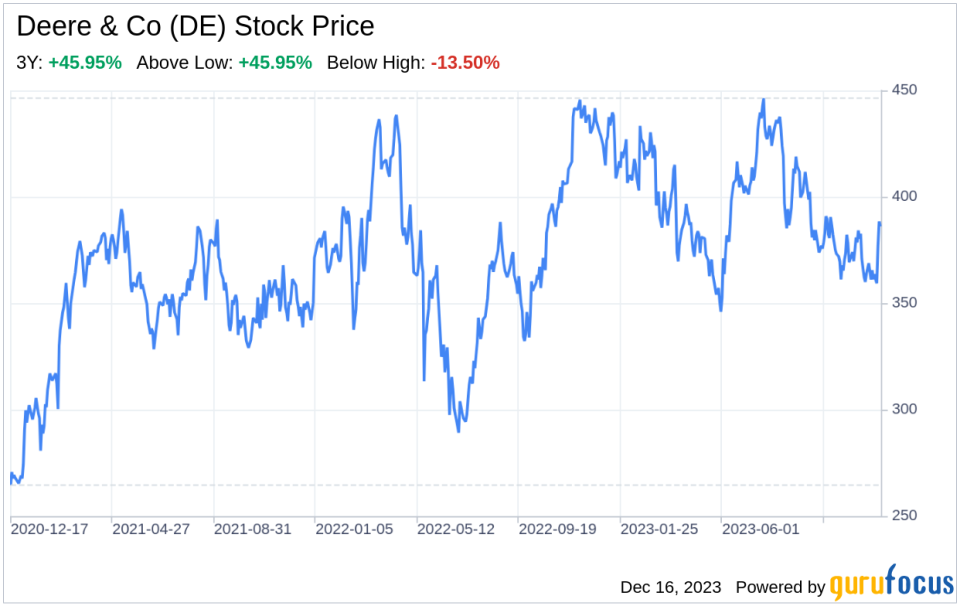-
Deere & Co showcases robust financial performance with significant growth in net sales and revenues.
-
Investment in technology and sustainability initiatives positions the company for future growth.
-
Global market presence and strong brand recognition continue to be key competitive advantages.
-
Challenges include navigating international trade policies and adapting to changing market demands.
On December 15, 2023, Deere & Co (NYSE:DE), a global leader in agricultural equipment, released its 10-K filing, revealing a year of substantial financial growth and strategic advancements. The company’s net sales surged to $55,565 million in 2023, up from $47,917 million in 2022, reflecting a strong market presence and demand for its products. Net income attributable to Deere & Co also rose impressively to $10,166 million, compared to $7,131 million the previous year. This financial overview underscores Deere & Co’s solid financial foundation, which is crucial for sustaining investments in innovation and expansion. With a market capitalization of $110.75 billion as of April 28, 2023, Deere & Co stands as a formidable player in the heavy machinery industry, poised for continued success.


Deere & Co (NYSE:DE) has consistently demonstrated its ability to navigate the complexities of the global market, leveraging its strengths to maintain a competitive edge. However, like any major corporation, it faces a dynamic set of challenges and opportunities that could influence its future trajectory. The following SWOT analysis, derived from Deere & Co’s latest SEC 10-K filing, provides a comprehensive look at the company’s internal and external strategic factors.
Strengths
Market Leadership and Brand Recognition: Deere & Co’s strong brand equity, built over nearly two centuries, continues to be a significant asset. In 2023, the company’s net sales and revenues reached $61,251 million, a testament to its market leadership. Deere’s brand is synonymous with quality and reliability, which has helped to cultivate a loyal customer base and a dominant position in the agricultural equipment sector. The company’s investment in technology, such as precision agriculture, further reinforces its brand as an innovator, attracting customers seeking advanced solutions.
Financial Services Synergy: John Deere Capital, the company’s financial services arm, provides a strategic advantage by offering financing to customers and dealers. This not only facilitates equipment sales but also contributes to the company’s revenue streams. In 2023, finance and interest income added $4,683 million to the total net sales and revenues, highlighting the significance of this synergy between manufacturing and financial services.
Global Operational Footprint: Deere & Co’s extensive dealer network, with over 2,000 locations in North America and roughly 3,700 globally, ensures wide-reaching market access and customer support. This network is a critical strength that enables the company to efficiently distribute its products and provide after-sales services, fostering customer satisfaction and repeat business.
Weaknesses
Dependence on Agricultural Market Cycles: Deere & Co’s performance is closely tied to the cyclical nature of the agricultural sector. Fluctuations in commodity prices, farm incomes, and overall economic conditions can significantly impact equipment sales. While the company has diversified into construction and forestry equipment, agriculture remains a substantial portion of its business, making it vulnerable to sector-specific downturns.
Research and Development Costs: Continuous innovation is vital for maintaining competitiveness, but it comes at a high cost. Deere & Co’s research and development expenses were $2,177 million in 2023, reflecting the company’s commitment to innovation. However, these costs can strain financial resources, especially if market conditions weaken or if the return on investment in new technologies does not materialize as expected.
International Trade Risks: As a global entity, Deere & Co is subject to international trade laws and policies that can affect its operations. Tariffs, import/export restrictions, and geopolitical tensions can disrupt supply chains and increase costs, potentially eroding the company’s profitability and competitive position.
Opportunities
Technological Advancements: Deere & Co’s focus on digitalization, autonomy, and alternative power technologies presents significant growth opportunities. The company’s Smart Industrial Operating Model and Leap Ambitions aim to enhance customer value and sustainability. By capitalizing on these technological trends, Deere can expand its market share and enter new segments, such as electric and autonomous vehicles.
Emerging Markets Expansion: There is considerable potential for growth in emerging markets, where demand for agricultural and construction equipment is rising. Deere & Co’s established global presence positions it well to capture this growth by tailoring products and services to meet the specific needs of these regions.
Sustainability Initiatives: Increasing emphasis on sustainable practices in agriculture and construction offers Deere & Co the chance to lead in providing eco-friendly equipment solutions. This aligns with global efforts to reduce carbon emissions and can attract customers prioritizing environmental stewardship.
Threats
Competitive Pressure: The heavy machinery industry is highly competitive, with several global and regional players vying for market share. Companies like Caterpillar, CNH Industrial, and Kubota represent significant competition, and Deere & Co must continuously innovate and improve its offerings to maintain its leadership position.
Economic Uncertainty: Economic downturns, trade disputes, and other macroeconomic factors can lead to reduced demand for Deere & Co’s products. The company’s performance is particularly sensitive to the agricultural sector’s health, which is influenced by a complex interplay of global economic conditions and policies.
Technological
This article, generated by GuruFocus, is designed to provide general insights and is not tailored financial advice. Our commentary is rooted in historical data and analyst projections, utilizing an impartial methodology, and is not intended to serve as specific investment guidance. It does not formulate a recommendation to purchase or divest any stock and does not consider individual investment objectives or financial circumstances. Our objective is to deliver long-term, fundamental data-driven analysis. Be aware that our analysis might not incorporate the most recent, price-sensitive company announcements or qualitative information. GuruFocus holds no position in the stocks mentioned herein.
This article first appeared on GuruFocus.














